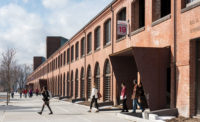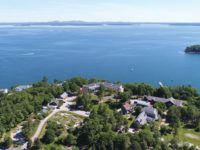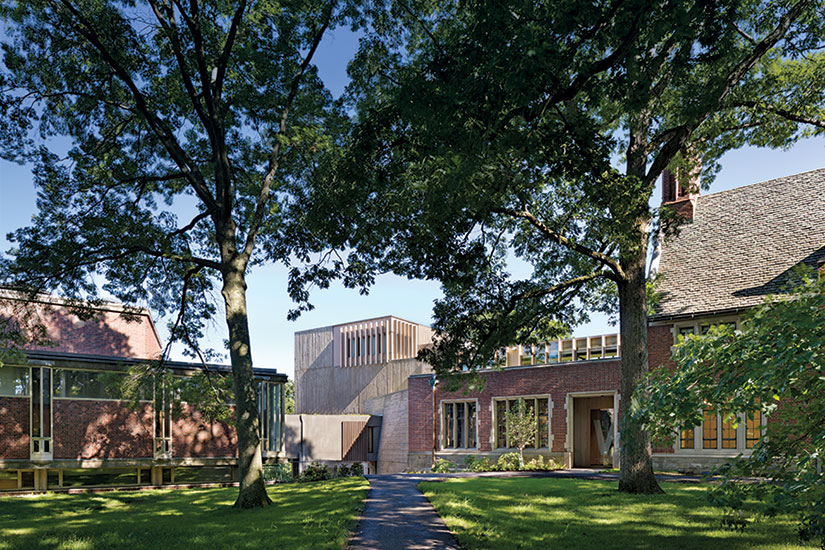Pendleton West Addition and Renovation at Wellesley College by KieranTimberlake
Wellesley, Massachusetts

The addition serves as a linchpin between Pendleton West and the Jewett.
Photo © Michael Moran

The addition stands sentry alongside the Arts Passage, which squeezes up between the new building and Jewett, connecting the west campus to the Academic Quad. A bush-hammered granite base references nearby historic structures.
Photo © Michael Moran

The Arts Passage travels beneath a bridge between the addition and Jewett Hall; the new stair sits alongside the narrow preexisting one (indicated by the brick).
Photo © Michael Moran

The addition’s glazed east facade reveals interior circulation and looks out to a new terrace, which provides another entry point to the building from the north.
Photo © Michael Moran

Acoustical ceiling panels add a splash of color to the concrete surfaces that carry inside.
Photo © Michael Moran

The old building was gutted and opened up to provide flexible, loftlike studios.
Photo © Bob O'Connor

Strategically placed windows connect the oak-lined rehearsal hall (opposite) to the surrounding tree canopy.
Photo © Michael Moran

Image courtesy KieranTimberlake

Image courtesy KieranTimberlake

Image courtesy KieranTimberlake

Image courtesy KieranTimberlake











Architects & Firms
Founded in 1870 in a leafy suburb 12 miles west of Boston, Wellesley College, a liberal arts institution for women, has a student body of just 2,350. Intimate though it is, its alumnae roster, which includes Madeleine Albright and Hillary Rodham Clinton, is sometimes referred to as “the most powerful women’s network in the world.” So it is fitting that a modern addition on the historic Academic Quad here, by KieranTimberlake, is diminutive but has a quiet power and a complex agenda.
The campus, with a 1921 master plan by Frederick Law Olmsted (and another by Michael Van Valkenburgh in 1998), is something to behold. Five hundred acres of rolling hills and vales, wetland meadows, and woodlands are traversed by rambling paths and offer views out across Lake Waban. At the campus’s heart, Norumbega Hill, is the Academic Quad, ringed by buildings at its periphery, including Pendleton Hall. Designed by Charles Klauder in 1934 for the physics and chemistry departments, the western half of the collegiate Gothic building was later turned over to house the arts, which, for 30-odd years, occupied the lab building in an ad hoc manner.
Additional Content:
Jump to credits & specifications
About five years ago, the college began planning some capital improvements, including those for visual arts and music—which also occupied Paul Rudolph’s Jewett Arts Center (1958), adjacent to Pendleton. The campus had no formal choral or orchestral rehearsal space, and the improvised visual arts studios were sorely outdated, and inadequate for the needs of the burgeoning field of media arts. After an invited RFP process, KieranTimberlake, which had renovated the school’s chapel in 2006, was selected for the project, including a gut renovation of Pendleton West, and the 10,000-square-foot addition—the maximum allowable size for the tiny site—wedged between Jewett and Pendleton.
In recent years, Wellesley’s campus has grown to the west, with Rafael Moneo’s Davis Museum, as well as a large sports complex and Mack Scogin Merrill Elam’s Lulu Chow Wang Campus Center farther down the hill. This shift made what had been a back-door entry to the Academic Quad—a narrow brick stair between Pendleton and Jewett—into a front door. “There was an opportunity here to make the master plan whole again at this particular juncture,” says founding partner Stephen Kieran, “by celebrating passage from the newly developed campus of the west up to the historic campus of the Academic Quad—it had to be not just a building, but also a portal.”
Not only would the project need to reunite the arts (including bridging to Jewett) and celebrate a threshold, the architects realized; it would also have to connect the quad and the residential buildings to the north, negotiating the site’s 35-foot grade change and making the quad fully accessible for the first time. “We thought about it broadly as a building that was about physical passage,” says Kieran. “That started to inform a project that was about movement on a lot of levels and gave rise to strategies inside.” Seeing this little corner as a way to resolve a slew of campus circulation problems, the architects came up with the idea of pulling the stairs and elevators (which were not code-compliant) out of Pendleton and into the new addition. Along with removing the double-loaded corridors of the old building, this strategy would solve another problem—not enough building to accommodate the program—by enabling the team to maximize the space in the old science hall. “That one move unlocked everything programmatically,” says Kieran, noting that it allowed the team to accommodate all the new visual-arts studios—from sculpture to printmaking to digital media—in the historic building. Here they have created flexible interiors re-envisioned as loftlike, state-of-the-art studios, with concrete floors and exposed systems. “We were thinking about how the building could intermingle traditional art forms and new media,” says Phyllis McGibbon, professor of art and the building director and faculty-client lead, “and make the student experience more holistic.” Consolidating the visual arts in Pendleton meant that the new structure besides its circulation functions, could be dedicated to housing music: a rehearsal hall, recital salon, and classroom—acoustically sensitive spaces that are best served by a purpose-designed building.
The addition’s tower-like form, which calls out its mission as a gateway, was driven in part by tight physical and regulatory constraints, but also took shape in response to creating a 35-foot-high rehearsal space that would meet the various acoustical demands of different music forms. It also speaks to its neighbor; the architects liken the building to a fourth pavilion added to Pendleton’s three gabled ends that reach out toward the lake.
Choosing concrete—which contrasts with the quad’s predominantly brick vocabulary—made sense for a variety of reasons. The material helps the building assert itself as a portal through its distinctness while subtly nodding to the Rudolph and Klauder buildings, with their precast and limestone copings and trims. On a pragmatic level, its thermal and acoustical mass were beneficial, but it was also perfect since the building functions as a retaining wall on its steeply sloping site. Of course, concrete has aesthetic appeal too, and its versatility enticed the architects to apply it in many forms. Vertical and horizontal board-formed concrete—both precast panels and cast-in-place—as well as “as-cast” and sandblasted cast-in-place concrete give the exterior a rich tactility. “It’s a building for making,” says associate Tim Peters, referring to the complete project, “so it should express how it’s made.”
The team carried this effect inside. Responding to the surrounding forest, they started considering the whole building as cast from wood, with the material’s memory imprinted by the formwork outside and in interior circulation areas, and the presence of warm white oak lining the music spaces. The rehearsal hall’s proportions lend the space a grandeur, but the honey-colored slats give it warmth, bringing it down to earth.
Wellesley does not build much, but when it does, it does so with intent. Embarking on this project, the team was keenly aware of the campus dialogue—across time and between designers—that they were entering. Quietly and thoughtfully, they have joined that conversation.
CreditsArchitect: KieranTimberlake 841 North American Street Philadelphia, PA 19123 215 922 6600 KieranTimberlake.com
Personnel in architect's firm who should receive special credit: Stephen Kieran, FAIA David Riz, FAIA Marilia Rodrigues, AIA Tim Peters, AIA Jeremy Leman Brendan Miller Yves Gauthier, AIA Emily Scrimger Darby Kline Elizabeth Lovett-Keshet
Architect of record: KieranTimberlake 841 North American Street Philadelphia, PA 19123 215 922 6600 KieranTimberlake.com
Interior designer: Marguerite Rodgers Ltd. (furnishings only)
Engineers Mechanical, Electrical, Plumbing, Fire Protection: Altieri Sebor Wieber Structural: LeMessurier Civil: Nitsch Engineering
Consultants Landscape Architect: Michael Van Valkenburgh Associates Acoustical: Acentech Lighting: Fisher Marantz Stone Environmental Health and Safety: OEHS2 Sustainability: Atelier 10 Code: Jensen Hughes Specifications: Wilson Consulting
General contractor: Consigli
Photographer: Michael Moran (OTTO), Bob O’Connor |
Specifications
Exterior Cladding Masonry: Bush Hammered Granite: Fletcher Granite Precast concrete: Strescon Wood: Duratherm Window Corporation Moisture barrier: Carlisle Curtain wall: Duratherm Window Corporation
Roofing Elastomeric: Sika Metal: Revere Copper
Windows Wood frame: Duratherm Window Corporation
Glazing Glass: Viracon
Doors Wood doors: Duratherm Window Corporation Special doors: Acoustical Doors: IAC
Hardware Locksets: Schlage Closers: LCN Exit devices: Von Duprin
Interior Finishes Acoustical ceilings: Decoustics Cabinetwork and custom woodwork: Commercial Display and Design Paints and stains: Sherwin Williams Paneling: Commercial Display and Design Special interior finishes unique to this project: Polished and Trowelled Concrete: Ameripolish
Lighting Interior ambient lighting: Downlights: iGuzzini, Cree, Holophane Tasklighting: Elliptipar Exterior: Bega Dimming system or other lighting controls: nLight
Conveyance Elevators/escalators: Thyssenkrupp
Energy Energy management or building automation system: Automated Logic Controls Other unique products that contribute to sustainability: Green Roofs: Sedum Master |

















